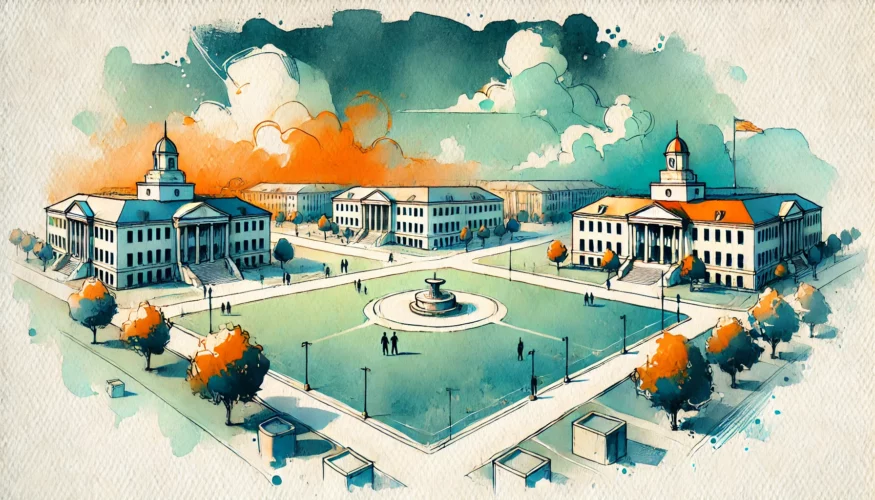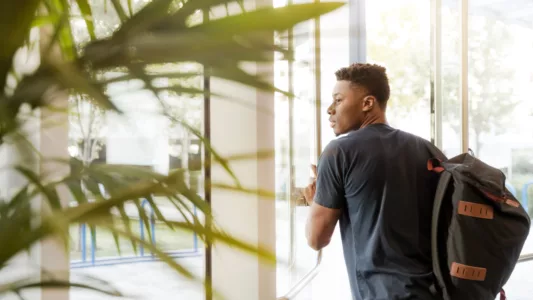ResearchBlack Boys & Men, Education & Skills
HBCUs at a crossroads: Addressing the decline in Black male enrollment

Summary
Black men account for only 26% of the students at Historically Black Colleges and Universities (HBCUs), down from 38% in 1976. In fact, there are fewer Black men enrolled at HBCUs today than in 1976. HBCUs have long served as valuable institutions for Black students, offering a unique environment that fosters academic achievement, mental well-being, and economic mobility.
More non-Black students offset these declines, but the reduced presence of Black men means fewer are benefiting from the supportive environments that HBCUs provide to help students succeed during and after college.
Key takeaways
- Enrollment of Black male students at HBCUs is currently below 1976 levels and declining more rapidly than in other colleges and universities.
- The share of non-Black students at HBCUs is now about equal to the share of Black male students, at 26% and 25% respectively.
- HBCUs enroll a higher proportion of lower-income students compared to non-HBCUs, and these students are nearly twice as likely to experience upward economic mobility.
- This decline in Black male students is influenced by factors such as inadequate K-12 preparation, a lack of Black male teachers, and financial barriers both individually and institutionally.
- Addressing these issues through targeted interventions and expanded funding may reverse the declining trend and increase the opportunities for Black men at HBCUs.
Introduction
Historically Black Colleges and Universities (HBCUs) were established before the Civil Rights Act of 1964 to provide educational opportunities for Black Americans, who were largely excluded from other institutions. HBCUs are still regarded as hubs for Black excellence and safe havens for Black students. But they have not been immune to the broader trend of declining enrollment among Black men.¹ In absolute numbers, there are fewer Black men enrolled at HBCUs than in the mid-70s.²
Figure 1
HBCUs have experienced an overall enrollment decline of 11% since 2010, consistent with trends seen across all colleges and universities. The decline in Black male enrollment is more pronounced, however, with a 25% decrease at HBCUs and a 22% decline across all institutions. While the percentage drop at HBCUs is only slightly greater than elsewhere, the impact is much greater on HBCU campuses, since Black male students make up a much larger share of the student body.
In recent years there have been some more hopeful signs. After significant declines in male enrollment in 2019-2020 because of the COVID-19 pandemic, HBCUs experienced an increase in applications and enrollment in 2020-2022, following the murder of George Floyd and in the COVID recovery.³ Enrollment among Black men has increased since 2020, outpacing other groups, although total number of Black men still remains below pre-COVID levels.² The question for HBCUs is whether these recent trends continue, or whether enrollment reverts to previous patterns.
Data note
Throughout this brief, we use data from Integrated Postsecondary Education Data System (IPEDS).
When we refer to Black students, they are students who have indicated they are “Not Hispanic; Black or African American only”. This classification is based on IPEDS reporting standards, which categorize students based on how they self-identify their race and ethnicity and is aligned with common practices. These practices yield mutually exclusive racial categories, and may result in a slight undercount of students who may consider themselves Black but fall outside the IPEDS classification used in our analysis. Conversely, Non-Black is precisely defined as any student who does not identify as only Black or African American.
As many non-Black students as Black male students at HBCUs
The enrollment of Black men and Black women at HBCUs has declined since 2010, but there has been a steady increase in the enrollment of non-Black students. This is not by accident. It is one of several responses by HBCUs to address Black enrollment declines and funding challenges.⁴
Figure 2
The share of non-Black students at HBCUs has increased to 24%, compared to 15% in 1976. Since 2010, there have been significant increases in the share of Hispanic and Multi-racial students while the share of white students has slightly decreased and the share of Asian students has remained steady. Part of this increase may be due to changing practices around racial identification, for example the general increase in multiracial identities.⁵ However, the increase in the share of non-Black students at HBCUs has not resulted in a decline in the share of Black women on campus, who continue to account for around half the student body. Instead, the share of Black men at HBCUs has dropped sharply to 26%, down from 31% in 2005 and 38% in 1976. The share of non-Black students (25%) now matches that of Black men (26%).
Figure 3
There is also considerable variation among HBCUs, including some bright spots. Among the top 20 largest HBCU campuses (with a combined average total fall enrollment of 7,972), the share of Black men ranges from 4% at St. Philip’s College (also a Hispanic serving institution) to 33% at Alabama A&M University. Morgan State University and Tennessee State University represent the median of these larger schools with 26% Black male enrollment. North Carolina A&T, the largest HBCU, has a slightly higher Black male share at 29%, while Howard University, the second-largest, has a Black male share of just 19%. Only 20 of 101 HBCUs, excluding single-sex institutions, have a Black male enrollment share of 40% or higher. With the exception of South Carolina State University, these 20 are small private schools, typically with less than 1,000 students.
HBCUs can uniquely support Black students
The significance of HBCUs extends beyond their historical role in providing access to education. HBCUs are uniquely positioned to address the specific needs of Black students, offering an environment that not only supports academic achievement but also promotes mental health, social mobility, and economic empowerment.
One study found that after controlling for student preparedness, institutional financial health, instructional spending, and other institutional factors, the graduation rate for Black students at HBCUs is 10 percentage points higher than those at non-HBCUs.⁶ The findings also suggested that HBCUs improve the graduation rate of both Black men and Black women equally.
Figure 4
HBCUs also play an important role in the graduate school pathway. HBCUs account for just 13% of 4-year degrees awarded to Black students, but HBCU graduates account for nearly 50% of Black doctoral recipients in agricultural science, 31% in mathematics, 23% in science and engineering, and 21% in psychology.⁷ ⁸ HBCUs have produced more Black applicants to medical schools than non-HBCUs, and they are responsible for educating 40% of Black engineers and 50% of Black lawyers.⁹ ¹⁰ Black HBCU graduates are also more likely to report having a better experience in college, receiving more support, and have greater social capital.¹¹
HBCUs enroll more lower-income students than non-HBCUs, and these students are more likely to experience upward economic mobility, as Figure 5 shows.¹² Students from HBCUs have upward mobility rates (i.e. moving from the bottom to top of the income distribution) about twice as high as those from all US colleges and universities. In addition, over half of HBCU students experience at least some upward economic mobility (up at least one income quintile), a rate which is about 50% higher than all US colleges and universities.
Figure 5
Black students who attend HBCUs have higher levels of self-esteem and report fewer depressive symptoms compared to those attending non-HBCUs, according to some research.¹³ ¹⁴ This may be attributed to the stronger sense of belonging and cultural affirmation that Black students often experience at HBCUs.¹⁵ ¹⁶ These may in turn contribute to enhanced later academic achievement, social capital and post-graduation success.¹⁷
It is not all good news, of course. There is some evidence that wages for HBCU graduates have risen more slowly than for Black students at other institutions.¹⁸ Students attending HBCUs also accumulate more college tuition debt and have lower rates of repayment.¹⁹ These trends point to potential areas where HBCUs may benefit from more support, especially in terms of funding.
Conclusion
The declining enrollment of Black men at HBCUs is a serious concern, especially given their current economic and education outcomes. It reflects a broader lack of progress for Black men compared to other groups in higher education. Several factors contribute to this challenge, including:
- Pathway Problem: Black boys often receive inadequate preparation in K-12 education due to economic and social disparities that impact many Black communities and their school systems, leading to significant barriers to college readiness.²⁰
- Lack of Representation: The scarcity of Black male teachers means Black boys may not view academic success as attainable or relevant to them, further discouraging their pursuit of higher education.²¹
- Belief Gap: Non-Black teachers frequently have lower expectations for Black students, negatively impacting their academic performance and aspirations.²²
- Financial Barriers: Black adults without degrees are more likely to cite personal finances and financial aid as critical factors in enrolling or remaining enrolled in college.²³ Without adequate financial support, many young Black men are opting out of college and choosing to enter the workforce to secure an income.
- Underfunding: HBCUs have historically faced underfunding, which limits their ability to provide the financial aid and resources needed to attract and support Black male students.²⁴ ²⁵ Increased awareness of the need for support in recent years has led to a rise in contributions to HBCUs, helping to bolster the recent surge in enrollment. However, much more work remains to be done to sustain and build on this momentum and ensure that Black men reap some of the benefits.
Targeted interventions in K-12 education in Black communities, increasing the representation of Black male teachers, and expanding funding opportunities for HBCUs and their potential students could all help increase Black male enrollment. Reforms in these critical areas could help HBCUs realize their full potential in supporting the educational and economic advancement of Black men.
Subscribe to our newsletter
Get the latest developments on the trends and issues facing boys and men.
- National Center for Education Statistics. (n.d.). IPEDS trend generator: Fall enrollment (headcount) by race/ethnicity. U.S. Department of Education. Retrieved from https://nces.ed.gov/ipeds/TrendGenerator/app/build-table/2/3?rid=47&cid=48
- U.S. Department of Education, National Center for Education Statistics. (2023, December). Higher Education General Information Survey (HEGIS), “Fall Enrollment in Colleges and Universities,” 1976 through 1985 surveys; Integrated Postsecondary Education Data System (IPEDS), “Fall Enrollment Survey” (IPEDS-EF:86-99); and IPEDS Fall Enrollment component, Spring 2001 through Spring 2022 (final data) and Spring 2023 (provisional data). https://nces.ed.gov/programs/digest/d23/tables/dt23_313.20.asp
- Green, Y. J. (2024, June 3). HBCU enrollment is on the rise. The HBCU Career Center. https://www.thehbcucareercenter.com/blog/hbcus-as-a-college-choice-is-on-the-rise
- Walker, L. J., Goings, R. B., Spencer, D., Jr., McDonald-Lowe, S., & Palmer, R. T. (2020). Embracing change: The importance of pluralism at historically Black colleges and universities. In C. S. Platt, A. A. Hilton, C. Newman, & B. N. Hinnant-Crawford (Eds.), Multiculturalism in higher education: Increasing access and improving equity in the 21st century (pp. 129–142). Information Age Publishing, Inc.
- Rico, B., Jacobs, P., & Coritz, A. (n.d.-a). Nearly a third reporting two or more races were under 18 in 2020. United States Census Bureau. https://www.census.gov/library/stories/2023/06/nearly-a-third-reporting-two-or-more-races-under-18-in-2020.html
- Gordon, E. K., Hawley, Z. B., Kobler, R. C., et al. (2021). The paradox of HBCU graduation rates. Research in Higher Education, 62, 332–358. https://doi.org/10.1007/s11162-020-09598-5
- The United States Government. (2024, May 16). The economics of HBCUs. The White House. https://www.whitehouse.gov/cea/written-materials/2024/05/16/the-economics-of-hbcus/#:~:text=Although%20they%20make%20up%20less,degrees%20earned%20by%20Black%20students
- National Science Foundation, National Center for Science and Engineering Statistics. (2021). Diversity and STEM: Women, minorities, and persons with disabilities 2021 (NSF 21-321). Alexandria, VA. Available at https://ncses.nsf.gov/pubs/nsf21321/report
- Gasman, M., Smith, T., Ye, C., & Nguyen, T. H. (2017). HBCUs and the production of doctors. AIMS Public Health, 4(6), 579-589. https://doi.org/10.3934/publichealth.2017.6.579
- Thurgood Marshall College Fund. (n.d.). About HBCUs. Retrieved from https://www.tmcf.org/about-us/member-schools/about-hbcus/
- Gallup, Inc. (2015). Gallup-USA Funds minority college graduates report. USA Funds.
- Center for Minority Serving Institutions. (2019). Moving upward and onward: Income mobility at historically Black colleges and universities. Rutgers University. Retrieved from https://cmsi.gse.rutgers.edu/sites/default/files/EMreport_R4_0.pdf
- Price, G. N., & Viceisza, A. C. G. (2023). What can historically Black colleges and universities teach about improving higher education outcomes for Black students? Journal of Economic Perspectives, 37(3), 213-232.
- McDill, V. (2023, March 31). New study examines mental-health outcomes for Black students attending historically Black colleges and universities. School of Public Health – University of Minnesota. https://www.sph.umn.edu/news/new-study-examines-mental-health-outcomes-for-black-students-attending-historically-black-colleges-and-universities/#:~:text=For%20Black%20students%20who%20reported,to%20those%20who%20attended%20PWIs
- Nguemeni Tiako, M. J., Wages, J. E., & Perry, S. P. (2023). Black medical students’ sense of belonging and confidence in scholastic abilities at historically Black vs predominantly White medical schools: A prospective study. Journal of General Internal Medicine, 38(1), 122–124. https://doi.org/10.1007/s11606-022-07716-w
- Winkle-Wagner, R., & McCoy, D. L. (2016). Feeling like an “Alien” or “Family”? Comparing students and faculty experiences of diversity in STEM disciplines at a PWI and an HBCU. Race Ethnicity and Education, 21(5), 593–606. https://doi.org/10.1080/13613324.2016.1248835
- Reeves, R. V., & Ford, T. N. (2019, February 14). College for people like me: How majority-Black campuses boost social mobility. Brookings. https://www.brookings.edu/articles/college-for-people-like-me-how-majority-black-campuses-boost-social-mobility/
- Fryer, R. G., & Greenstone, M. (2010). The changing consequences of attending historically Black colleges and universities. American Economic Journal: Applied Economics, 2(1), 116–148. https://doi.org/10.1257/app.2.1.116
- Joyce, M. (2024, May 1). Race and economic mobility: College value at historically Black colleges and universities. The Institute for College Access & Success. https://ticas.org/racial-equity-agenda/race-and-economic-mobility-college-value-at-historically-black-colleges-and-universities-2/
- Bowman, B. T., Comer, J. P., & Johns, D. J. (n.d.). Addressing the African American achievement gap: Three leading educators issue a call to action. National Association for the Education of Young Children (NAEYC). https://www.naeyc.org/resources/pubs/yc/may2018/achievement-gap
- Reeves, R. V. (2024, February 27). Missing misters: Gender diversity among teachers: AIBM. American Institute for Boys and Men. https://aibm.org/research/missing-misters/
- Gershenson, S. (2015, August 29). The alarming effect of racial mismatch on teacher expectations. Brookings. https://www.brookings.edu/articles/the-alarming-effect-of-racial-mismatch-on-teacher-expectations/#:~:text=For%20example%2C%20when%20a%20black,degree%20than%20the%20black%20teacher
- Gallup, Inc. (2024). State of higher education 2024. Retrieved from https://www.gallup.com/analytics/644939/state-of-higher-education.aspx?thank-you-report-form=1
- Escobar, M., et al. (2023). Barriers and facilitators to obtaining external funding at historically Black colleges and universities (HBCUs). Journal of STEM Education: Innovations and Research, Suppl.SPECIAL ISSUE, 24(1), 42-50. ProQuest. http://proxy.library.nyu.edu/login?qurl=https%3A%2F%2Fwww.proquest.com%2Fscholarly-journals%2Fbarriers-facilitators-obtaining-external-funding%2Fdocview%2F2865584782%2Fse-2%3Faccountid%3D12768
- Njoku, N., & Murray, L. (2023). Greater funding, greater needs: A report on HBCU funding during COVID-19 and a case for continued support. Phylon (1960-), 60(2), 91–100. https://www.jstor.org/stable/27281917
Related Research

Black Boys & Men, Education & Skills
Getting men re-engaged in college
Men are 42% of students but 51% of stopouts. Why men leave college and how re-enrollment programs can bring them back.

Black Boys & Men, Education & Skills
How “gifted education” can be a game changer for disadvantaged boys
Gifted programs boost college entry for low-income boys—a 28-point jump for those just over the IQ threshold.

Black Boys & Men, Education & Skills
Data Spotlight: Where do men get their education degrees?
Education degrees go mostly to women—just 17% of BAs & 21% of MAs go to men, limiting the pipeline for male teachers.